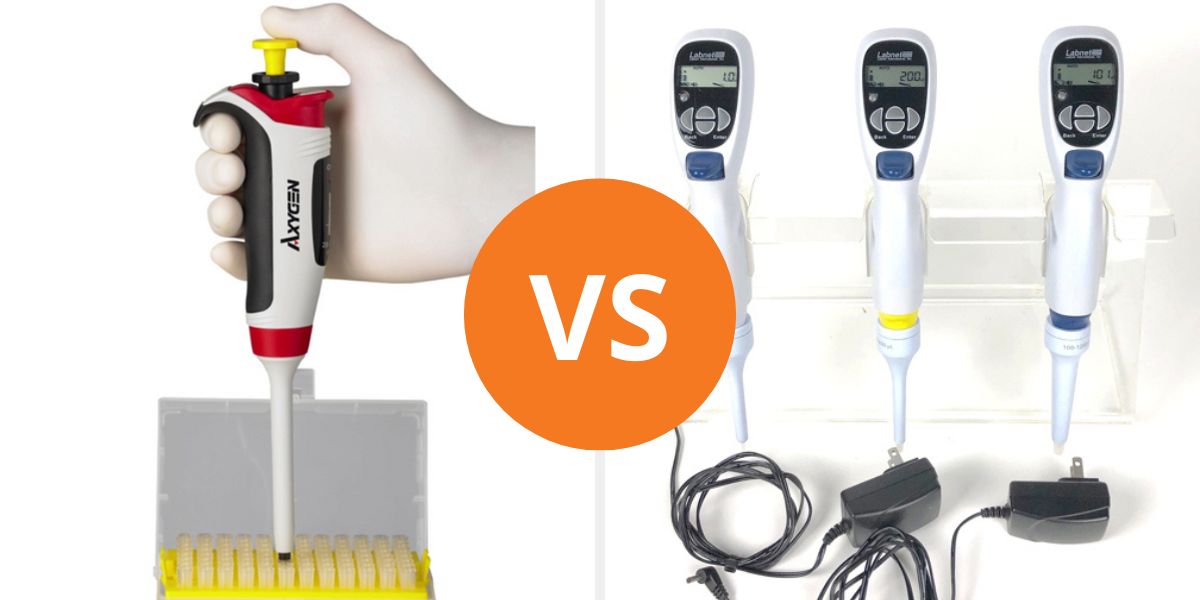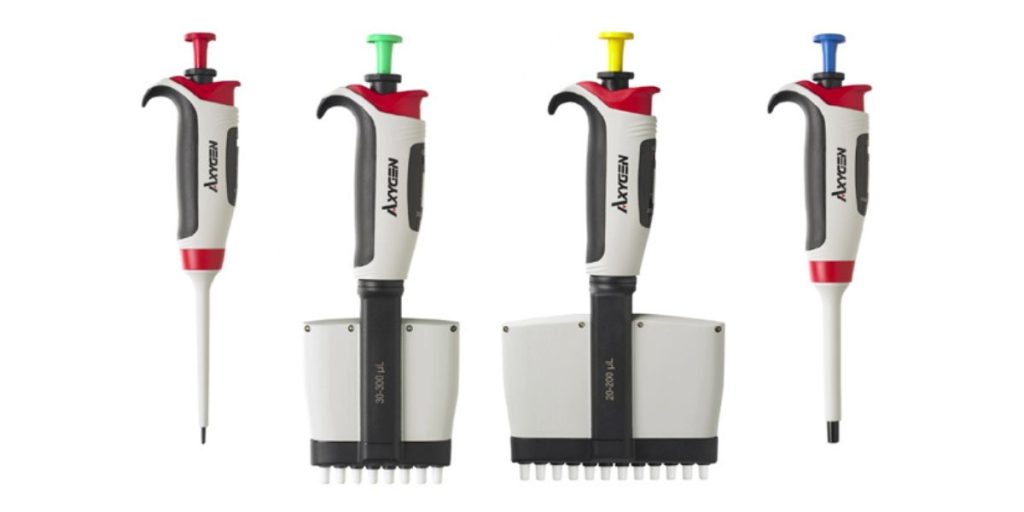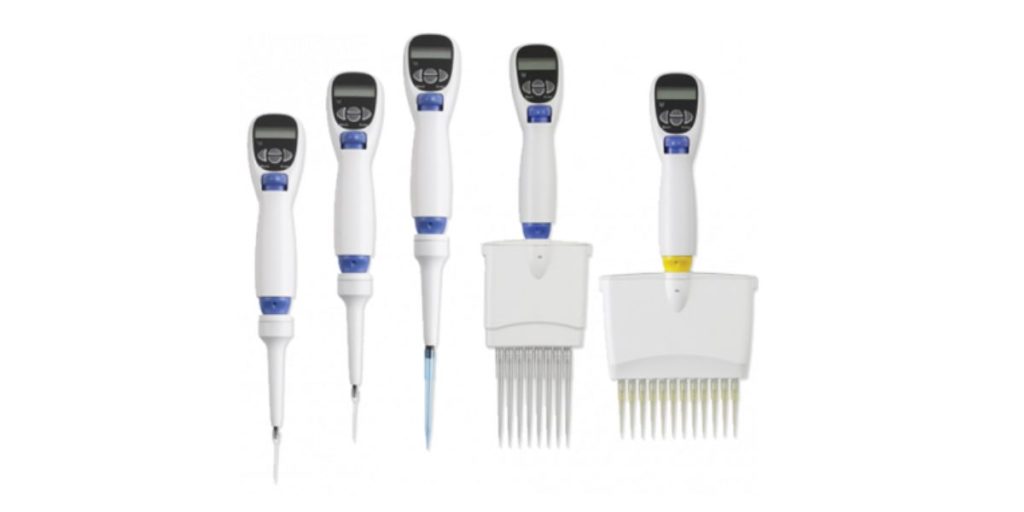The pipette is a simple yet vital lab tool that’s necessary for precise liquid handling. Pipettes are essential for working with sensitive DNA samples, reagents and cell cultures.
Today, many of the world’s leading lab equipment brands manufacture electronic pipettors, leaving you to choose between a trusted manual pipetting system or a new advanced electronic automated pipetting system.
The choice between manual and electronic pipetting can significantly impact the quality and reliability of your results, reducing errors in your research. Additionally, selecting the right pipette can save you time and money.
In this article, we’ll explore the differences between manual pipettes and electronic pipettes, examining their respective advantages and limitations to help you determine which option is best suited to your laboratory’s needs for optimal performance and efficiency.
Manual Pipettes: A Time-Tested Approach
Pictured here are Axygen’s Axypet® Pro Single and Multi-channel Pipettes.
Manual pipettes, also known as mechanical pipettes, are the traditional choice for liquid handling in scientific research. These laboratory instruments rely on the user to physically operate the plunger using their hands, drawing up and dispensing liquids through a disposable pipette tip. They provide precise control and are well-suited for routine lab tasks.
Manual pipettes come in a range of sizes, including micro-volume pipettes capable of handling just a few microlitres and larger models that can transfer up to several millilitres. This versatility makes them adaptable to various research applications.
Pros of Manual Pipettes
- Cost-effective: Manual pipettes are usually more affordable than their electronic counterparts. That makes them a practical choice for smaller budgets. Their affordability extends to maintenance costs as well.
- Easy to use: The straightforward operation of manual pipettes requires minimal training, allowing researchers to quickly become proficient in using them. Lab personnel widely adopt manual pipettes because they are easy to use.
- Versatile: Mechanical pipettes can handle various applications, from simple liquid transfers to complex multi-step protocols in scientific research. They show adaptability and support diverse workflows.
Cons of Manual Pipettes
- Human error could lead to inconsistency: The accuracy and precision of manual pipetting can vary depending on the user’s technique, which can lead to inconsistencies between samples and experiments. Variability may affect research reproducibility.
- Muscle fatigue: Repetitive pipetting motions can cause hand and wrist strain, especially during high-throughput workflows, resulting in repetitive strain injury (RSI) if not managed carefully.
- Limited throughput: Manual pipetting can be a time-consuming process, particularly when handling large numbers of samples. This can impact overall laboratory productivity. Automating repeat tasks improves lab throughput and efficiency.
Electronic Pipettes: Enhancing Precision and Automation
Pictured here are Labnet’s Excel™ Electronic Single & Multi-Channel Pipettes.
Electronic pipettes, also referred to as electronic pipettes or automated pipettes, provide consistency in liquid handling. They use a mechanism with a motor to control the aspiration and dispensing of liquids and often feature digital volume displays and programmable settings. These features increase precision and reduce user error.
The electronic pipette offers advantages in terms of speed and consistency compared to manual pipetting. The debate of manual vs automatic pipetting highlights how electronic models simplify workflows and lower the risk of repetitive strain injuries.
Pros of Electronic Pipettes
- More accurate and precise: electronic pipettes are engineered to deliver highly consistent and accurate liquid volumes, reducing the risk of variability between samples. Accurate pipetting increases experimental reliability.
- Enhanced ergonomics: The motor operation of the automated pipettor minimises the physical strain associated with manual pipetting, which helps to prevent RSI and improve user comfort. Users experience less fatigue during repeat tasks.
- Higher throughput: Automated liquid handling capabilities allow electronic pipettes to handle a larger number of samples in a shorter amount of time, boosting lab productivity. The increased efficiency speeds up the flow of work.
- Versatile: Many electronic pipettes offer a range of advanced features, such as custom protocols and the ability to handle a wide variety of liquid volumes. These features expand their utility in work applications.
Cons of Electronic Pipettes
- Higher cost: electronic pipettes typically have a higher upfront cost when comparing manual vs electronic pipetting, which should be a consideration for laboratories with smaller budgets. Budget constraints might limit their adoption.
- More complex: The additional features and automation of electronic pipettes require more extensive training and familiarisation for users, notably those used to traditional manual pipetting.
- Additional maintenance: Electronic pipettes generally require more regular maintenance and calibration to perform optimally, adding to the total cost of ownership.
Choosing the Right Pipette for Your Needs
When considering manual vs electronic pipetting for your research, it’s important to consider the specific needs and requirements of your laboratory. Here are some factors you will want to keep in mind:
Throughput and productivity
If your research involves high-volume or repetitive liquid handling tasks, then an electronic pipette may be the better choice. It can considerably increase throughput and decrease the time spent on manual pipetting.
Accuracy and precision
For applications that demand the utmost accuracy and consistency, such as qPCR, ELISA or other sensitive assays, an automated pipettor can provide the level of precision you need to guarantee reliable results.
Ergonomics and user comfort
In the case that you’re prone to hand or wrist strain from prolonged pipetting, an electronic pipette can help alleviate such issues and improve comfort for users.
Budget and cost of ownership
While electronic pipettes may cost you more initially, the long-term benefits might outweigh the initial investment. Calculate the total cost of ownership, including maintenance and calibration requirements.
Versatility and adaptability
Should your laboratory’s needs be likely to evolve over time, an electronic pipette may be ideal. It has programmable features and can handle a range of liquid volumes for more flexibility and future-proofing.
Ultimately, the choice between manual vs electronic pipetting will depend on the requirements and priorities of your research. Carefully evaluate the pros and cons of each pipetting option. That way, you can make an informed decision that will help ensure the accuracy, efficiency and reliability of your experiments. Choosing wisely will support your research goals.
The Different Types of Manual Pipetting Systems
Despite the advent of automation, manual pipettes remain indispensable for tasks requiring flexibility and user control. At Fisher Biotec, we supply Australian laboratories with a wide range of manual pipettes tailored to meet diverse needs. Some of the different types of manual pipettes you may come across include:
Single-channel manual pipettes
Designed to transfer liquids one at a time and are ideal for applications requiring precise volume measurements.
Multi-channel manual pipettes
These pipettes have multiple channels, allowing simultaneous dispensing of liquids into multiple wells of a microplate. They are commonly used in high-throughput assays and ELISA.
Fixed-volume manual pipettes
These are set to dispense a specific volume, ensuring consistency and reducing user error. They are useful for repetitive tasks.
Adjustable-volume pipettes
These allow users to set the desired volume within a specific range, providing flexibility for different applications.
Manual pipette controllers
These devices assist in the aspiration and dispensing of liquids when using serological pipettes. They offer precise control over liquid handling.
The Different Types of Automated Liquid Handling Systems
When investing in electronic pipetting systems, you’ll also find different types. Electronic pipettes are part of a broader range of automated liquid handling systems. At Fisher Biotec, we supply Australian laboratories with various automated liquid handling systems depending on the customers’ needs. These include:
Automated workstations
Automated workstations are sophisticated systems designed to handle complex liquid handling tasks with minimal user intervention. They integrate multiple functions such as pipetting, dispensing, and mixing, making them ideal for high-throughput screening.
Benchtop pipettors
Benchtop pipettors are compact and versatile devices that automate the pipetting process for medium to high-throughput applications. They provide consistent and precise liquid handling, improving efficiency and reducing human error in routine laboratory tasks.
Single-channel electronic pipettes
Single-channel electronic pipettes offer precise and ergonomic control for transferring small volumes of liquid. They are ideal for tasks requiring high accuracy and reproducibility, such as sample preparation.
Multi-channel electronic pipettes
Multi-channel electronic pipettes enable simultaneous liquid transfer across multiple wells, significantly speeding up processes like plate filling and assay setup. They are particularly useful in high-throughput environments where efficiency and consistency are paramount.
Electronic pipette controllers
Electronic pipette controllers provide enhanced control and ease of use for aspirating and dispensing liquids with serological pipettes. They offer adjustable speed settings and ergonomic designs, reducing hand fatigue and increasing accuracy in liquid handling tasks.
Contact Fisher Biotec to Learn More About The Latest Innovations in Liquid Handling
Fisher Biotec supplies various liquid handling products from the biggest names in scientific research to laboratories across Australia. Whether you’re in need of multi-channel, single-channel, manual, or automatic pipetting solutions, you’ll find everything you need and more. With account managers servicing each state of Australia, you can count on our personalised support and timely deliveries to get your big ideas moving. Browse some of our best sellers online or get in contact with our friendly team to discuss your unique requirements.




